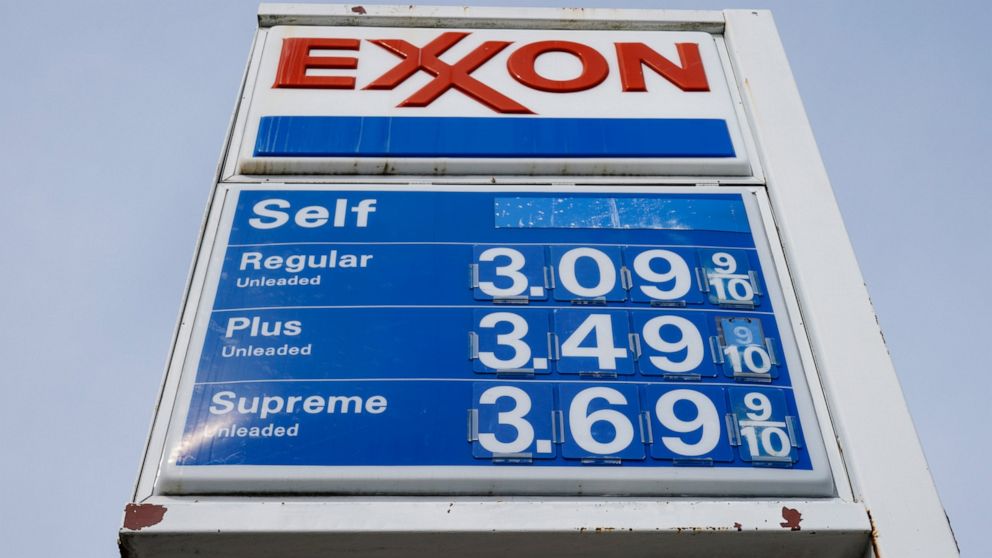Exxon posts $2.7B quarterly profit after unprecedented year
NEW YORK — Exxon Mobil on Friday reported first-quarter profits of $2.73 billion after a tumultuous year led to major spending reductions.
The oil giant brought in $59.15 billion in revenue, up 5% from $56.16 billion during the same quarter last year. It exceeded analyst projections for the quarter.
The oil and gas industry has been struggling with massive losses after the global coronavirus pandemic forced millions of people to shelter at home and travel ground to a halt, pummeling demand for fuel.
But as some countries have picked up the pace of vaccine distribution, there are glimmers of hope that the pandemic may get under control and economies will recover. Oil companies anticipate that will mean more cars on the road and planes in the air. But the virus is still devastating many communities around the globe.
The latest earnings news follows a catastrophic year for the oil industry. Exxon lost $22.4 billion in 2020, reporting its largest-ever losses in the fourth quarter, after the pandemic throttled demand for oil. Planes were grounded, many people ditched their daily commutes and worked from home, and business travel ground to a halt in favor of virtual meetings. The company had not posted an annual loss since Exxon and Mobil merged in 1999.
To stem some of the losses, Exxon reduced capital spending by 30% in 2021 and announced in October that it would slash 1,900 jobs from its global workforce. The oil, gas and chemical industries laid off 107,000 workers between March and August of last year, according to Deloitte Insights.
“We made some tough decisions and committed to bold actions,” said CEO Darren Woods in a conference call with investors Friday. The company expects to achieve $6 billion of annual savings by 2023, compared to 2019, he said.
“Throughout this time, we’ve never lost sight of the long-term fundamentals of our business,” Woods said. “We knew economies would recover, populations and living standards would continue to grow, ultimately driving demand for our products and an industry recovery.”
The Irving, Texas, company produced 3.8 million barrels of oil per day in the first quarter, up 3% from the fourth quarter of 2020.
Per-share earnings reached 64 cents, or 65 cents if one-time costs are removed, topping the 59 cents that Wall Street was looking for, according to a survey by Zacks Investment Research.
Meanwhile, Chevron on Friday reported a $1.4 billion profit in the first quarter, down from $3.58 billion at the same time last year, due to the pandemic and the impacts of winter storms.
Chevron brought in $32.03 billion in revenue, up from $31.5 billion at the same time last year. The San Ramon, California, company expects to further reduce its workforce during the current quarter, Chief Financial Officer Pierre Breber said in a conference call with investors.
Some economists are projecting that demand for oil may never return to pre-pandemic levels.
“It’s just hard to see how those numbers materialize into higher fuel demand,” said Peter McNally, global sector lead for industrials, materials and energy at Third Bridge. “That said, we are seeing an impact that when people get vaccinated, they’re traveling, whether it’s by car or by plane.”
Investors are pressuring oil and gas companies to find different sources of revenue, in part due to many countries’ increasingly aggressive goals to fight global warming.
Both Exxon and Chevron touted their efforts to invest in low-carbon technologies and expand their efforts to capture carbon dioxide.
“Go back two years and try to find an investor presentation that was talking about low-carbon emissions,” said Stewart Glickman, energy equity analyst at CFRA Research. “Nowadays, all of these firms are tripping over themselves to talk about what are they doing to help the climate change situation.”
Some oil companies have captured carbon dioxide from their operations for years. They often inject the carbon dioxide underground to help produce more oil — raising questions about how much the practice reduces emissions — or sell it for use in other industries. Exxon launched its Low Carbon Solutions business, which is evaluating and advancing plans for more than 20 new carbon-capture and storage opportunities around the world, the company said.
“The question is if you can make money out of it,” McNally said. “They’re betting on this carbon capture idea. Some people disagree with it, but it’s not an unproven technology.”
After dipping below $0 per barrel last spring, oil prices rebounded to pre-pandemic levels. The price of a barrel of benchmark U.S. crude oil tripled from about $20 at the end of March 2020 to $60 at the same time this year.
The price boost is largely the result of supply constraints after U.S. production had declined due to low prices and the OPEC cartel kept oil off the market. A barrel of U.S. benchmark crude was selling for about $63.50 Friday. Brent crude, the international standard, was selling for $66.70.
![]()


